6. When one or several positions on the heater dies one resort is to
fit a Pulse Width Modulator that does the same job but lasts forever…
|
|
| |
For tall
enthusiasts with large feet ;)
Cut away for more space in the footwell
Screw off the fixture bracket for the fuse cover and cut away
app 3cm of the fuse cover plate. Attach the fuse cover only
with both 'screw rivets'.
|
| 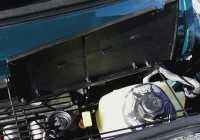
|
|
| |
<ising
for Veedol Oil only at continental cars ? |
| |
|
| |
electric
boot lid opener |
| |
280mm
disks and green stuff at the front |
| |
|
| |
Switches
in both door panels to interupt the mirror heater |
| |
grills
|
| |
|
| |
the
clean exhaust
1. The
exhaust system has been with me for over 6 years now looking
like this. It is a big improvement over the original system
and all that has heard it thinks it is a genuine sports system
;o) Much more free flowing and a nicer sound…. The internals
are as the drawing on your site.
|
| |
|


well used DIY cat bypass pipe with additional lamba sensor |
2. The
original lambda sonde is of no use if one wants to get the REAL
reading of lean or rich running. This because the MEMS inserts
a pre-chosen voltage over the sonde when going for full throttle…
So the only way to tell is to have a second one, preferably
placed in the bypass tube. Any bar-graph readout will do, there
are several simple DIY ones described on the net. This one solved
the "flat spot " problem.
May be
this site can help to DIY the application :) (thanks Rob)
|
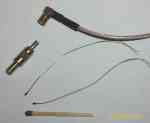
various NTC and PTC temperature sensors
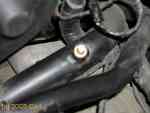
one of added instead of the rear bleed bolt |
3. There
are several good quality temp. sensors on the market that can
be used for additional temp control. After fitting the "remote
thermostat" I fitted one in the former bleed screw in the
engine department. This gives total control of the coolant temp
at the inlet side. The re-worked cooling system now varies +/-
3 deg. C from idle to full load!! |



shielding works EMC protection at the main harness.

shielding works , clamp + and minus cable together with cable
ties
|
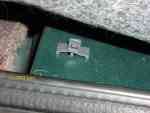 cable clamp rivet
cable clamp rivet
4. The induced
magnetic field as well as the voltage diffs between front and
rear are best fixed by shielding the main cable at the drivers
side and adding a real earth return from the battery to the
generator (or at least to somewhere on the engine block).For
the main cable assy. I used ordinary alu foil that after another
layer of PVC-tape was earthed at one point ONLY. Best place
is close to the big rubber grommet that goes from the cabin
into the engine compartment. No more "sleepy" left
foot on long journeys and less interference on the radio as
well…. |
| C.R.B.
Simeon, Hampshire, United Kingdom
MG's in the last 30 years have had a reputation
for rusting out in suspiciously quick time. I think the MGB
put the battery at the back and the generator/alternator at
the front using only the bodywork(which rotted quickly by coincidence)
to connect them. The MGF does it the other way around with the
battery at the front and an even juicier alternator at the 'mid'
- but to my way of thinking just as risky. The coolant pipework(already
critical for HGF) is reported to rust out(potentially disastrously)in
shockingly quick time. This afternoon I just spent a couple
of hours making a 300A wire connection between the alternator
and the battery, tied off neatly to existing routes.
I don't know why but it feels sensible as a precaution. No boat
with an engine sets out without a sacrificial anode and so should
no car - just don't make it your bodywork!
Carl in Sweden posted something mentioning this a couple of
months ago and I am sure he is right but like I said - I don't
know why.
Anybody out there?
Charles
Posted 10 April 2006 at 16:13:46 UK time
Carl, Sweden.
Hi Charles,
yes, I think it is a good measure to avoid the heavy currents
that flow in the body of the "F" ! There are some
pictures and info on Dieters site on how I did it. Basically
just a insulated heavy multistranded wire from the battery to
the generator running under the car .
All this was triggered by finding that on a totally pampered
car that never seen any rain,only running in the summertime
and handwashed and run warm after every wash there was heavy
corrosion on the lower part of the radiator !! Measuring with
equipment borrowed from work it was found that heavy currents
circulated in the body. On top of this there is no ground cable
from the alternator,soley relying on the dodgy contact made
by the altenator bracket...
I also reduced the magnetic field and disturbance on the radio
by shielding the main cables running along the left sill under
the carpet (on a LHD car) from the rear to the front panel,relays
and fuses. This can be seen at Dieters site.
BR, Carl.
Posted 10 April 2006 at 23:18:26 UK time
Charles, Hampshire,
Carl,
Thanks for the reply. I wish I could explain exactly why we
should all be doing this simple measure to preserve our 'Fs'.
It is so obvious if you think about it and is bound to have
contributed to or been the principal cause of many simple HGFs,
starting problems, radio reception and alarm issues over the
years. It will become more of a problem and any damage alresdy
done cannot be reversed(my VVC was 10 this year). People even
report that the aluminium aftermarket replacement radiator pipes
start rotting quite soon after fitting.
It is much cheaper than low coolant level alarms and about the
same time to effect. Can we prove it to anyone? - hence both
the title of my thread and the 'general' rather than 'technical'
listing. Maybe somebody will hear............summer is coming
- a good time to be rolling about in the dirt under your 'F'
:O)
BR
Charles
Posted 11 April 2006 at 07:11:23 UK time
carl, Sweden.
All this is well known within the industry.
Big players as Volvo have made this alteration ( here engine
at front ,battery at rear close to rear seats)
The main objective to NOT rely on the body as main earth return
for them was the very high magnetic field induced at the drivers
side during driving.
Many drivers complained about "sleepy legs" despite
the best seats in the class.After the re-build things were normal
again.
But of course it is all down to cost,copper is expensive and
the cable needs to be heavy to have any effect.
The induced field is of course the result of high currents in
the car body.This was of minor concern years ago when the electric
system on cars were simple and some got away with 2 fuses only
(The Mini) ;O).
/ Carl.
(c)
copy from a thread at the MG Cars BBS
|
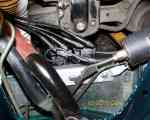
VVC coils location changed |
5. The ignition-coils
are much happier where they are now, no dirt or water that can
make start-problems. |

Heater control circuit
|
6. When
one or several positions on the heater dies one resort is to
fit a Pulse Width Modulator that does the same job but lasts
forever… |